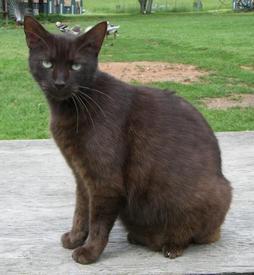
It is uncertain how the Havana Brown adopted its name, although there are two theories. One theory suggests that the breed was named after Havana tobacco because of its dark brown colour, while the other claims the cat was named after the Havana rabbit which also has a chocolate coat. Believed to have hailed from Siam – what is now Thailand – the Havana Brown was thought to bring good luck and banish evil. For this reason it was a popular companion cat in the Far East, eventually being brought to England in the 1880s. Following a cat show in 1928 where the Havana Brown won a special award for its chocolate coat, the breed lost favour, and two years later the Siamese Cat Club practically banned the breed altogether. It was re-developed in the 1950s by the careful breeding efforts of a group of enthusiasts and gained full championship status from the Cat Fancier’s Association in 1964.
Highly distinctive in appearance, the Havana Brown is characterised by an agile frame, with long legs, a triangular face and large ears. The green eyes are bright and very striking, contrasting well with the chocolate brown coat. This coat is typically short and close-fitting, recognised only in a dark brown – leaning towards red rather than black – and is extremely soft to the touch. The Havana Brown is a moderate shedder and requires minimal grooming to maintain its appearance. For this reason, it is a suitable breed choice for the house-proud!
This affectionate, playful and intelligent cat is well suited to domestic living, being highly trainable and adapting quickly to new situations and people. Forming strong bonds with its owner, a Havana Brown will behave with loyalty, love and tenderness. Unlike the Siamese, the Havana Brown is a quietly confident cat that communicates softly when it wants attention. Due to the rarity of the breed most owners prefer to keep their cat inside; because of its intelligence, however, it is essential that plenty of interactive toys are available, as well as adequate space to exercise and play. On average, a healthy Havana Brown will weigh 6-10 pounds, with a life expectancy of 15 years.
Typically very healthy and resilient, the Havana Brown’s rarity makes any genetic or breed-specific conditions difficult to determine. One complaint the breed is susceptible to, however, is calcium stone development in the urinary tract.
(Photograph: http://www.flickr.com/photos/rikkis_refuge/)
Do you own a Havana Brown? Let others know what they're like!
Related products
Blenheim Havana Brown Mexican Noseband
from £18.50
Blenheim Havana Brown Stirrup Leathers
from £18.50
Blenheim Havana Brown Market Harborough
from £49.99
Blenheim Havana Brown Standing Martingale
from £27.99
Blenheim Havana Brown Bib Martingale
from £39.99
Blenheim Havana Brown Elastic Breastgirth
from £26.99
Blenheim Clincher Havana Brown Inhand Bridle
from £44.99
Blenheim Plain Havana Brown Inhand Bridle
from £32.95